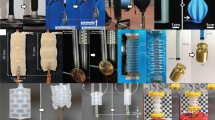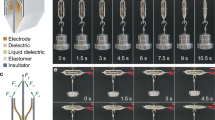Abstract
Compared to biological muscles, current technical actuators are limited in their performance and versatility to realize human-like locomotion. In order to overcome the actuator limitations for locomotion, we introduce the hybrid EPA actuator as a combination of electric and pneumatic actuators in this chapter. As a new variable impedance actuator, the EPA design provides direct access to the control and morphological properties. We demonstrate that with the EPA, the actuator limitations could be clearly reduced in vertical hopping.
Access this chapter
Tax calculation will be finalised at checkout
Purchases are for personal use only
Similar content being viewed by others
References
Geyer, H., Seyfarth, A., & Blickhan, R. (2003). Positive force feedback in bouncing gaits?. Proceedings of the Royal Society of London. Series B: Biological Sciences, vol. 270, no. 1529, pp. 2173–2183.
Grimmer, M., Eslamy, M., Gliech,S., & Seyfarth, A. (2012). A comparison of parallel-and serieselastic elements in an actuator for mimicking human ankle joint inwalking and running. In Robotics and Automation (ICRA), 2012IEEE International Conference on, IEEE, pp. 2463–2470.
Hosoda, K., Rode, C., Siebert, B., Vanderborght, T., Weckx, M., & Lefeber, D. (2017). Actuation in legged locomotion, in Bioinspired Legged Locomotion, Elsevier, pp. 563–622.
Hosoda, K., Takuma, T., Nakamoto, A., & Hayashi, S. (2008). Biped robot design powered by antagonistic pneumatic actuators for multi-modal loco-motion. Robotics and Autonomous Systems, 56(1), 46–53.
Hurst, J. (2019). Walk this way: To be useful around people, robots need to learn how to move like we do. IEEE Spectrum, 56(3), 30–51.
Klute, G. K., Czerniecki, J. M., & Hannaford, B. (1999). McKibben artificial muscles: Pneumatic actuators with biomechanical intelligence. In Advanced Intelligent Mechatronics, 1999. Proceedings. 1999 IEEE/ASME International Conference on, IEEE, pp. 221–226.
Komi, P. V. (2008). Stretch-shortening cycle. Strength and Power in Sport, 3, 184–202.
Mathijssen, G., Lefeber, D., & Vanderborght, B. (2015). Variable recruitment of parallel elastic elements: Series-parallel elastic actuators (spea) with dephased mutilated gears. IEEE/ASME Transactions on Mechatronics, 20(2), 594–602.
Nelson, G., Saunders, A., Neville, N., Swilling, B., Bondaryk, J., Billings, D., et al. (2012). Petman: A humanoid robot for testing chemical protective clothing. Journal of the Robotics Society of Japan, 30(4), 372–377.
Okunaka, R., Ikemoto, S., & Hosoda, K. (2018). A new concept of pneumatic tactile sensor using pressure wave propagation in a soft chamber. In 2018 IEEE International Conference on Robotics and Biomimetics (ROBIO), IEEE, 2018, pp. 1809–1813.
Pratt, J. E., & Krupp, B. T. (2004). Series elastic actuators for legged robots, in Defense and Security. International Society for Optics and Photonics, 135–144.
Pratt, G. A., & Williamson, M. M. (1995). Series elastic actuators. In 1995 IEEE/RSJ International Conference on Intelligent Robots and Systems, Los Alamitos, Calif. IEEE Computer Society Press, pp. 399–406.
Raibert, M., Blankespoor, K., Nelson, G., Playter, R., & Team, T. B. (2008) Bigdog, the rough-terrain quadruped robot, in Proceedings of the 17th World Congress, Proceedings Seoul, Korea, pp. 10,822–10,825.
Sakagami, Y., Watanabe, R., Aoyama, C., Matsunaga, S., Higaki, N., & Fujimura, K. (2002). The intelligent ASIMO: System overview and integration, in Intelligent Robots and Systems, 2002. IEEE/RSJ International Conference on, IEEE, 2002, pp. 2478–2483.
Semini, C., Tsagarakis, N. G., Guglielmino, E., Focchi, M., Cannella, F., & Caldwell, D. G. (2011). Design of HyQ-a hydraulically and electrically actuated quadruped robot. Proceedings of the Institution of Mechanical Engineers, Part I: Journal of Systems and Control Engineering, p. 0 959 651 811 402 275.
Sharbafi, M. A., Rode, C., Kurowski, S., Scholz, D., Möckel, R., Radkhah, K., Zhao, G., Rashty, A. M., von Stryk, O., & Seyfarth, A. (2016) A new biarticular actuator design facilitates control of leg function in biobiped3. Bioinspiration & Biomimetics, 11(4), 046 003.
Sharbafi, M. A., & Seyfarth, A. (2017). How locomotion sub-functions can control walking at different speeds? Journal of Biomechanics, 53, 163–170.
Sharbafi, M., Shin, H., Zhao, G., Hosoda, K., & Seyfarth, A. (2017). “Electric- pneumatic actuator: A new muscle for locomotion,” in Actuators. Multi-disciplinary Digital Publishing Institute, 6, 30.
Sharbafi, M. A., Barazesh, H., Iranikhah, M., & Seyfarth, A. (2018). Leg force control through biarticular muscles for human walking assistance. Frontiers in Neurorobotics, 12, 39.
Van Ham, R., Vanderborght, B., Van Damme, M., Verrelst, B., & Lefeber, D. (2007). MACCEPA, the mechanically adjustable compliance and controllable equilibrium position actuator: Design and implementation in a biped robot. Robotics and Autonomous Systems, 55(10), 761–768.
Vanderborght, B., Albu-Schaeffer, A.,Bicchi, A., Burdet, E., Cald- well, D. G., Carloni, R., Catalano,M., Eiberger, O., Friedl, W., Ganesh, G., Garabini, M., Grebenstein,M., Grioli, G., Haddadin, S., Hoppner, H., Jafari, A., Laffranchi,M., Lefeber, D., Petit, F., Stramigioli, S., Tsagarakis, N., vanDamme, M., van Ham, R., Visser, L. C., & Wolf, S. (2013). Variableimpedance actuators: A review. Robotics and AutonomousSystems, 61(12), 1601–1614.
Verrelst, B., Van Ham, R., Vanderborght, B., Daerden, F., Lefeber, D., & Vermeulen, J. (2005). The pneumatic biped “Lucy” actuated with pleated pneumatic artificial muscles. Autonomous Robots, 18(2), 201–213.
Wisse, M., & Van der Linde, R. Q. (2007). Delft pneumatic bipeds. Springer Science & Business Media, Vol. 34.
Zhao, G., Sharbafi, M., Vlutters, M., Van Asseldonk, E., & Seyfarth, A. (2017). Template model inspired leg force feedback based control can assist human walking. In 2017 International Conference on Rehabilitation Robotics (ICORR), IEEE, pp. 473–478.
Author information
Authors and Affiliations
Corresponding author
Editor information
Editors and Affiliations
Rights and permissions
Copyright information
© 2021 Springer Nature Switzerland AG
About this chapter
Cite this chapter
Ahmad Sharbafi, M., Mohammadi Nejad Rashty, A. (2021). Hybrid Electric-Pneumatic Actuator. In: Beckerle, P., Sharbafi, M.A., Verstraten, T., Pott, P.P., Seyfarth, A. (eds) Novel Bioinspired Actuator Designs for Robotics. Studies in Computational Intelligence, vol 888. Springer, Cham. https://doi.org/10.1007/978-3-030-40886-2_6
Download citation
DOI: https://doi.org/10.1007/978-3-030-40886-2_6
Published:
Publisher Name: Springer, Cham
Print ISBN: 978-3-030-40885-5
Online ISBN: 978-3-030-40886-2
eBook Packages: Intelligent Technologies and RoboticsIntelligent Technologies and Robotics (R0)




